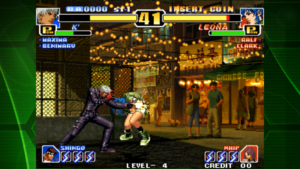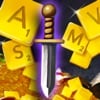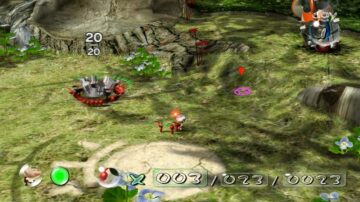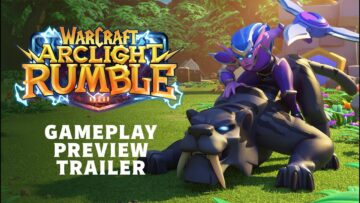 Sticking a thing together with another thing to make a thing is probably the game concept of the 21st century. From the rudimentary crafting systems in Level-5’s RPGs to the “oh no this is going to take over my life” infinite LEGO-style possibilities of Minecraft all the way up to weird mysterious grandmothers in Merge Mansion, the choice of the modern age is merging stuff. Even Link is in on it these days. Teeny Tiny Town (Free) is an interesting game, embracing the modern need to smack objects together until they inexplicably make a totally different thing while adding its own smart tweaks to the concept. I like it a lot, and I’m going to tell you why. That’s what we do here.
Sticking a thing together with another thing to make a thing is probably the game concept of the 21st century. From the rudimentary crafting systems in Level-5’s RPGs to the “oh no this is going to take over my life” infinite LEGO-style possibilities of Minecraft all the way up to weird mysterious grandmothers in Merge Mansion, the choice of the modern age is merging stuff. Even Link is in on it these days. Teeny Tiny Town (Free) is an interesting game, embracing the modern need to smack objects together until they inexplicably make a totally different thing while adding its own smart tweaks to the concept. I like it a lot, and I’m going to tell you why. That’s what we do here.
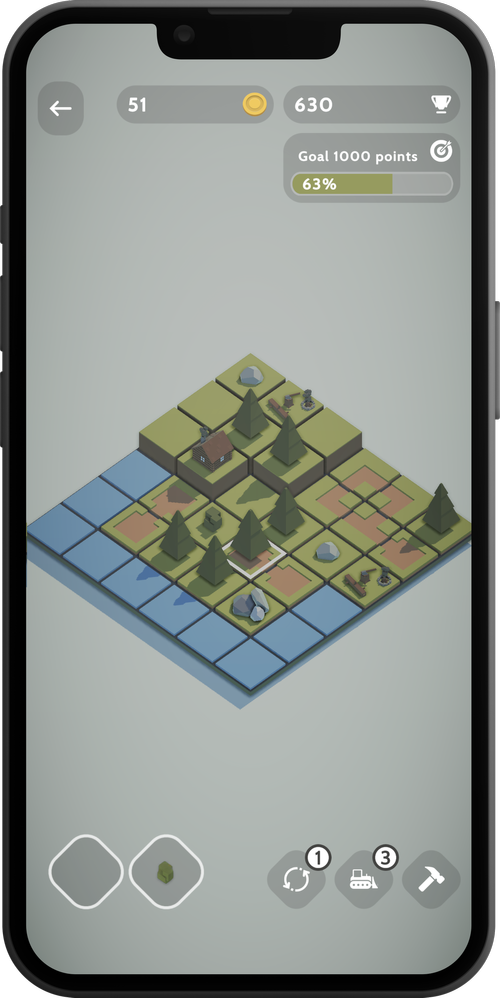 While I assume some of the people reading this are familiar with the basic mechanics at play here via other games like Merge Dragons, Merge Magic, Merge Mansion, Merge Nina Tucker, and so on, I’ll go ahead and explain things for those who aren’t. You’ve got a map divided into squares. The number of squares you get depends on the map you’ve picked, but the squares are finite. Each turn you’re given an object of some kind to place. If you place three or more of the same object in adjacent square (cardinally, no diagonals allowed), they’ll merge into a single higher level object. Those higher level objects can be merged into even nicer things, and so on. Of course, the more of these high level objects you have on your field, the longer it takes to make matches for them, and you only have so much space to work with. If you run out of empty squares, that’s the game.
While I assume some of the people reading this are familiar with the basic mechanics at play here via other games like Merge Dragons, Merge Magic, Merge Mansion, Merge Nina Tucker, and so on, I’ll go ahead and explain things for those who aren’t. You’ve got a map divided into squares. The number of squares you get depends on the map you’ve picked, but the squares are finite. Each turn you’re given an object of some kind to place. If you place three or more of the same object in adjacent square (cardinally, no diagonals allowed), they’ll merge into a single higher level object. Those higher level objects can be merged into even nicer things, and so on. Of course, the more of these high level objects you have on your field, the longer it takes to make matches for them, and you only have so much space to work with. If you run out of empty squares, that’s the game.
It’s a reliable template, because it allows for a lot of errors early on but becomes increasingly strategic the longer a game goes on. Players who just want to mess around don’t feel cheated, but the skill ceiling is extremely high. When you make a mistake, it’s usually clear what you could have done differently. This makes you want to try again, vowing not to make the same mistake twice. You will make the same mistake twice, thrice, and more, but the feeling is what is important here. The only real problem with this set-up is that a lot of players will eventually hit a plateau that they can’t quite break out of unless they get some lucky pulls with the piece distributions.
This is where I think Teeny Tiny Town breaks away from the pack. Not in the cleverest ways, but in ways that work. And that is what matters, isn’t it? There are a few mechanisms in place here to help you break through those plateaus and keep enjoying the game. First, you have a hold box. Two, if you buy the IAP. That allows you to take the current piece in play and shove it into storage for use at your leisure, skipping to the next piece. This is something Tetris and other falling block puzzlers incorporated somewhere along the line to help mitigate the effects of a particularly unlucky distribution of pieces and give the player at least the smallest bit of agency. I haven’t really seen it in this kind of game before, and I think it’s a terrific addition.
Next, you’ve got something a bit more usual but still welcome. There are a pair of useful power-ups that you can deploy in emergencies. First is the Swap, which allows you to… I mean, you can swap two pieces on the map. I probably don’t need to explain that. And I suppose I don’t need to explain the Bulldoze, which just outright removes a piece. I just did explain it, though. These power-ups are extremely limited, and are typically only offered to you when you reach one of the goals the game lays out for you. It generally takes longer and longer to achieve those goals as you play, so you really can’t rely on these items in any real sense. They’re your last resort, but again work to help you out of corners you’ve backed yourself into. Of course, if you want them, you have to forego taking the gold instead.
 Gold! I like this one. As you build houses, create treasures, and achieve goals, you get gold. Like in the real world, you can’t take it with you. Use it or lose it. And what can you use it on? Well, at any point you are free to pop into the shop where you can exchange those coins for a piece of your choice. The exact selection depends on how long you’ve been playing this particular round, and the prices go up on pieces the more frequently you buy them. Broadly speaking you will be able to make use of this option a lot more often than the power-up items, and they can really help you get out of the smaller binds you’ll find yourself in. At the same time, if you abuse them you’ll quickly find yourself broke and pantsless. Again.
Gold! I like this one. As you build houses, create treasures, and achieve goals, you get gold. Like in the real world, you can’t take it with you. Use it or lose it. And what can you use it on? Well, at any point you are free to pop into the shop where you can exchange those coins for a piece of your choice. The exact selection depends on how long you’ve been playing this particular round, and the prices go up on pieces the more frequently you buy them. Broadly speaking you will be able to make use of this option a lot more often than the power-up items, and they can really help you get out of the smaller binds you’ll find yourself in. At the same time, if you abuse them you’ll quickly find yourself broke and pantsless. Again.
Playing the game and completing goals will earn you an extra currency, and I can’t remember the name of it so let’s call them crystals. Or blueberries. I don’t know. But this currency can be used for two purposes. First, you can use it to unlock new maps. The game includes several maps, with each one adding new twists to the challenge. You can just pay cash money to unlock all of them along with some other perks, and I recommend you do that because the game feels built around plunking down those few bucks. You don’t need to, of course. The game is amusing enough even if you don’t. Maybe you like the grind. But the other thing you can use blueberry crystals for is to buy some starting perks, which is the last piece in the luck mitigation puzzle. If you’ve bought the unlock IAP, it’s really all you can use this currency for. You might as well make use of it.
Now, even with all of these mechanisms you will eventually fail. It’s how the game works, after all. But I think they work well to make the game feel more strategic and less about getting some blessings from the RNG gods. That’s a good thing, because this isn’t one of those games that is trying to shake you down endlessly for money. It needs to engage the player in a different way, and it certainly does. At first I was playing it like a usual merging game and tried to avoid reaching for the assists. I couldn’t precisely understand why Jared was so infatuated with it. But I let myself start playing the game the way it wants to be played, and that’s when it really started to shine. Here was the difference. More choices. More options to bail myself out when I act like the careless idiot I often am. Longer, richer gaming sessions. Quite nice.
You know what else is quite nice? How this game looks and sounds. It wants you to relax, and it does everything it can to build that mood. The visuals are pleasing to the eye, and it’s exciting to see what new things will be created from the various merges. The sound effects and ambient audio are lovely. I’ve been talking about Teeny Tiny Town in a bit of a clinical way, because that is just what struck me as I sat down to write this review, but it’s really a nice piece of art too. I’m not trying to ignore the aesthetics by any means. They’re well-done. Your eyes and ears will be happy.
Let’s talk about how the monetization works, because that’s a talk we always have to have about mobile games. It’s free! Wow, free is nice. But it’s not really free. You’ll have a limited number of turns unless you pay a buck-thirty. You’ll only have one hold slot, unless you pay another buck-thirty. And if you don’t want to grind out the blueberry crystals for the rest of the maps, that’s another buck-thirty. Or you can pay three bucks and you get everything properly unlocked. That’s what you want to do. The three bucks thing. It’s three lousy bucks. You won’t regret it.
Bringing things to a close, Teeny Tiny Town is not a wildly innovative game in the broad strokes, but the fact that it builds on the familiar is part of what makes it work so well. You probably already know how it works, and that knowledge base is exactly what makes it so freeing when you see what it’s doing differently from the usual game of this sort. This is a very smartly designed game, and I really appreciate that. It also doesn’t hurt that it has a keen art style and some genuinely chill audio. A winning package all around, and if you have even the smallest love for puzzle games, I think it’s a must-play.
- SEO Powered Content & PR Distribution. Get Amplified Today.
- PlatoData.Network Vertical Generative Ai. Empower Yourself. Access Here.
- PlatoAiStream. Web3 Intelligence. Knowledge Amplified. Access Here.
- PlatoESG. Automotive / EVs, Carbon, CleanTech, Energy, Environment, Solar, Waste Management. Access Here.
- BlockOffsets. Modernizing Environmental Offset Ownership. Access Here.
- Source: https://toucharcade.com/2023/07/06/teeny-tiny-town-review-a-masterful-mellow-merging-puzzler/
- 1
- 21st
- 250
- a
- able
- About
- abuse
- achieve
- act
- adding
- ADDITION
- adjacent
- after
- again
- age
- Agency
- ahead
- All
- allowed
- allows
- along
- already
- also
- always
- am
- an
- and
- Another
- any
- Apple
- appreciate
- ARE
- around
- Art
- as
- Assists
- assume
- At
- audio
- avoid
- away
- backed
- bail
- base
- BE
- because
- becomes
- been
- before
- Bit
- block
- both
- bought
- Box
- break
- broad
- broadly
- buffer
- build
- builds
- built
- but
- buy
- by
- call
- CAN
- Cash
- certainly
- challenge
- choice
- choices
- clear
- Clinical
- close
- Coins
- completing
- concept
- corners
- could
- course
- crafting
- create
- created
- Currency
- Current
- days
- depends
- deploy
- designed
- DID
- difference
- different
- distribution
- do
- does
- doing
- done
- down
- each
- Early
- Earn
- effects
- else
- embracing
- Endlessly
- engage
- enough
- ERRORS
- even
- eventually
- everything
- exactly
- exchange
- Exciting
- explain
- extremely
- eye
- eyes
- fact
- Fail
- familiar
- feel
- few
- field
- find
- First
- For
- Free
- frequently
- from
- game
- Games
- Games Like
- Gaming
- generally
- Get
- getting
- GitHub
- give
- given
- gmail
- go
- Goals
- goes
- going
- Gold
- good
- happy
- has
- Have
- help
- here
- High
- higher
- HIT
- hold
- houses
- How
- HTTPS
- i
- if
- important
- in
- includes
- increasingly
- innovative
- instead
- interesting
- into
- Is
- IT
- ITS
- JavaScript
- jpg
- just
- keen
- keep
- kind
- know
- knowledge
- last
- Lays
- least
- left
- less
- Level
- Life
- like
- Limited
- Line
- LINK
- Long
- longer
- looks
- lose
- lot
- love
- Luck
- Magic
- make
- MAKES
- mansion
- map
- Maps
- matches
- Matters
- maybe
- me
- mean
- means
- Mechanics
- mechanisms
- Merge
- merges
- merging
- Messenger
- might
- mitigate
- mitigation
- Mobile
- mobile games
- Modern
- monetization
- money
- mood
- more
- much
- my
- name
- need
- needs
- networks
- New
- Next
- Nice
- no
- not
- number
- objects
- of
- offered
- often
- on
- One
- only
- open
- Option
- Options
- or
- Other
- out
- over
- own
- pack
- package
- pair
- part
- particular
- particularly
- Pay
- People
- perks
- Picked
- piece
- pieces
- place
- plato
- plato data intelligence
- platodata
- platogaming
- play
- played
- player
- players
- Playing
- Plus
- Point
- pop
- possibilities
- prices
- probably
- Problem
- purposes
- Puzzle
- quickly
- quite
- Rating
- reach
- reaching
- Reading
- Real
- real world
- really
- recommend
- Relax
- reliable
- rely
- Remember
- Resort
- REST
- review
- rng
- round
- RPGs
- Run
- same
- see
- seen
- selection
- send
- sense
- sessions
- several
- Share
- shine
- Shop
- single
- skill
- Skype
- slot
- smaller
- smart
- So
- Social
- social networks
- some
- something
- sound
- Space
- Speaking
- square
- start
- started
- Starting
- still
- storage
- Strategic
- style
- swap
- Systems
- Take
- takes
- taking
- talk
- talking
- Telegram
- tell
- than
- that
- The
- The Game
- Them
- there
- These
- they
- thing
- things
- think
- this
- those
- though
- three
- Through
- time
- to
- together
- too
- totally
- tried
- try
- turn
- turns
- tweet
- Twice
- twists
- two
- typically
- Understand
- unlock
- until
- up
- use
- used
- usually
- various
- very
- via
- visuals
- want
- wants
- was
- way
- ways
- we
- welcome
- well
- What
- What is
- when
- where
- while
- WHO
- why
- will
- winning
- with
- Work
- works
- world
- WoW
- write
- you
- your
- yourself
- youtube
- zephyrnet
